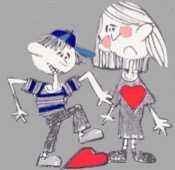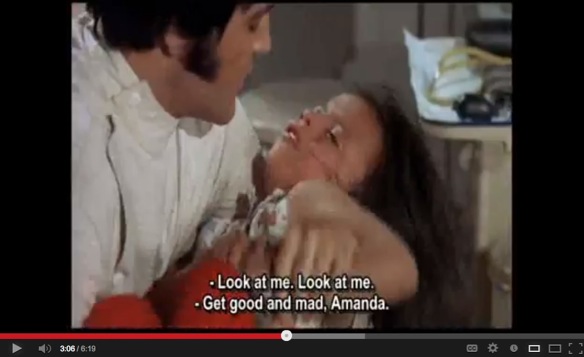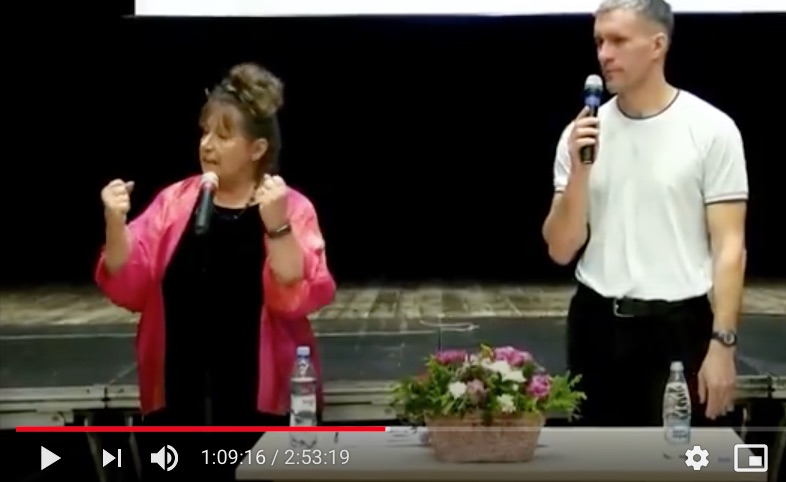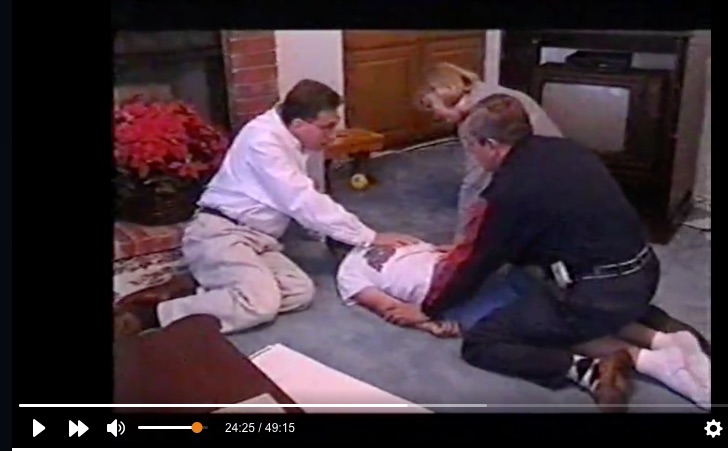Video Clips of
Attachment Therapy
The below are clips from training tapes made by Attachment Therapists and from news documentaries about Attachment Therapy. They are presented here for research and educational purposes only. These clips, while quite short, can be disturbing. These are especially not recommended for children.
Attachment Therapy (1993)
Neil Feinberg, LCSW
Attachment Center at Evergreen
COMMENTARY: The above clip is from a three-hour training tape made in 1993 by the Attachment Center at Evergreen (ACE; renamed the Institute for Attachment and Child Development), located in Evergreen, Colorado. Attachment Therapist Neil Feinberg, LCSW, demonstrates methods used in the Center’s “two-week intensive.” This training video set the standard for Attachment Therapy for years to come. It is unclear if the tape was ever marketed openly. In the two-week intensive, Holding Therapy sessions were conducted for approximately 2-3 hours each morning. Note that the boy’s right arm is pinned behind Feinberg’s back, while the other arm is restrained by the therapist or his assistant, Margaret Meineke. Feinberg, in showing the boy “who’s the boss,” tickles the boy relentlessly while ordering him to try to get up. He grabs at the boy’s left side, forces eye contact, shakes his head, threatens him, and forces him to yell out hateful statements. Denigration of the boy’s birth mother was a common theme. When not in therapy, the boy was subjected to further compliance training at the home of “therapeutic parents.” Comparison with the videos of Candace Newmaker’s Attachment Therapy, show at the trial of her therapists, indicates that these sessions are largely scripted, e.g. it is always assumed by the Attachment Therapist that adopted children harbor a “killing rage” since infancy and think often about killing their mothers. Feinberg finally lost his Colorado social work license in 2010. For years, Colorado State and county agencies (e.g. Weld County) sent children to ACE and other Attachment Therapists in Evergreen and around the state. Nancy Thomas, Terry Levy, Michael Orlans, and Foster Cline also worked at ACE and trained many other therapists from around the country in these techniques.
Attachment Therapy (1993)
Neil Feinberg, LCSW
Attachment Center at Evergreen
COMMENTARY: This is another clip from the Attachment Therapy training tape made the Attachment Center at Evergreen (now the Institute for Attachment and Child Development), with Attachment Therapist Neil Feinberg. In this psychodrama session, a boy is pulled in opposite directions by two women, one his adoptive mother and another portraying his birth mother. The women and Feinberg deliberately speak at the same time to create turmoil and confusion, while at the same time the child is expected to choose between mothers. Psychodrama is not considered appropriate for children age 16 and under, but it is unlikely that this would be considered appropriate for anyone. 
"Saving Children, Saving Families, Saving Lives”
Presentation by Forrest R. Lien, LCSW, Clinical Director/Therapist
The Institute for Attachment and Child Development (IACD; previously Attachment Center at Evergreen)
Birmingham, Alabama, January 14, 2005
No longer available for viewing
COMMENTARY: This video shows IACD still employing, among other abusive practices, Holding Therapy. Note that the boy is physically restrained: his right arm is pinned behind Lien's back, while Konnie Stoltz, an IACD “therapeutic foster mother,” holds the left arm. (Attachment Therapists typically claim that this does not constitute coercive restraint.) Lien appears to try to distress the boy by threatening abandonment by his adoptive mother. Although it seems that the boy was has no memories of his birth mother, the therapist claims she is exerting a controlling, negative influence over him. Lien rubs the boy’s restrained body and face with a photo of his biological mother. After the holding session, the boy is left alone in a room not knowing what comes next. This is typical of Attachment Therapy which believes children should be told as little as possible about future plans and events. Also standard is “firing” the child from therapy on the 5th day of the “two-week intensive.” Lien casually chews gum, perhaps impart to the boy his indifference and that it is the child, and the child alone, who bears all responsibility for the family’s problems. Stoltz speaks in the second DVD of this set about Attachment Therapy parenting.
Lien continues to practice today. In September 2009 he was placed on two years of probation by the Colorado Social Work Examiners Board. At approximately that time, this DVD was no longer offered for sale on the IACD website. In a presentation Lien made that same year, he claimed to be running pilot treatment programs for the child welfare departments of four Colorado counties: Larimer, Arapahoe, Denver, and Saguache.
Holding Time
Martha Welch, MD
COMMENTARY: This clip is from a training tape made by Martha Welch, MD. Welch, the author of the book Holding Time, sits in the background, supervising the mother in a style of Attachment Therapy commonly called “Compression Therapy.” This position, with the adult lying on top of the child, can pose numerous problems for the child, not least of which is the pressure put on the child’s abdomen which can restrict respiration. In this scene, the girl is ignored by both her mother and Welch when she complains that she “can’t breathe.” The younger girl in the next scene is ordered to show affection or go without her next meal.
Holding Time
Martha Welch, MD
COMMENTARY: Martha Welch, MD, first claimed that Holding Therapy could cure autism. When it failed to produce results, Welch taught that it could create emotional attachment. It appears that Attachment Therapy’s insistence on eye contact today may date back to when it was used as an autism treatment. Some desperate parents still try Holding Therapy to treat autism. This clip is of a “group hold” of autistic children at the Mothering Center in Britain. 
Holding Therapy in Eastern Europe
Jirina Prekop, Therapist
COMMENTARY: This clip begins showing Jirina Prekop (Prekopova), a popular proponent of Holding Therapy in the Czech Republic. In this film she supervises a session with a four-year-old autistic boy who struggles against the restraint. Note that the boy’s hand is placed over his abdomen, over which his mother weighs down on him. This prolonged position is not only painful, but it increases the risk and feelings of suffocation. Prekop considers herself a follower of Martha Welch and Nikolaas Tinbergen, a famous Dutch ethologist who believed that coercive restraint and forced eye contact could cure autism though there was no evidence supporting this claim. Prekop lectures extensively in Latin America and Europe. More info.
Cascade Family Center in Utah
48 Hours (1995)
Larry Van Bloem, LCSW
COMMENTARY: This is a clip from a 48 Hours program that aired in 1995. It was filmed at the Cascade Family Center in Utah and demonstrates several styles of Attachment Therapy: Holding Therapy (child in lap with its arm pinned behind the woman’s back), Compression Therapy (woman lying on top of child), and wrapping. The late Larry Van Bloem, LCSW, is shown elbowing a restrained boy in the ribs and abdomen. Such session were known to last for hours. The Cascade Family Center closed shortly after Van Bloem’s death. Legislative efforts to ban coercive restraint as therapy in Utah have failed repeatedly despite the full backing of mental health professional organizations in that state. 
“A Change of Habit” (1969)
COMMENTARY: This is the only scene from Elvis Presley’s last movie, A Change of Habit, with Mary Tyler Moore we can find, alas without the audio. The movie would have us believe that Presley’s character could cure autism with one session of “Rage Reduction,” as Attachment Therapy was called then. Note the insistence on eye contact and catharsis. It appears the child actress became genuinely distressed by the coercive restraint. Psychologist Robert Zaslow, an early proponent of Rage Reduction, was a consultant for this scene. Zaslow later lost his license to practice in California for abusing a patient with Rage Reduction.
“The Boarder”
COMMENTARY: This is the trailer for the movie The Boarder. In 2011, Jane E. Ryan, with the help of her community of Ravenna, Nebraska, raised enough money to take her screen play about “Reactive Attachment Disorder” to the big screen. Ryan, a nurse, counselor and mother of two adopted children with “RAD,” is a Foster Cline and Attachment Center at Evergreen enthusiast (see above top three clips). Typical of Attachment Therapy, Ryan promotes an unrecognized definition of RAD and attributes numerous violent and negative features to RAD.
The movie’s website gives the Director’s Vision as: “It’s time to wake up and change the way people look at adorable-looking children who act their hurt and rage out first on family members, then later, on society. No one wants to hear this, but children as young as four regularly attempt or kill family pets then threaten to kill thosze [sic] who object. Others stealthily cruise their homes at night setting fires, wielding knives, frightening siblings and worse.” Ryan commented to a reporter that, “Practically all the symptoms and all the circumstances that surround RAD show up in one way or another in the script.”
Attachment Therapy’s all-inclusive definition of RAD has been denounced by the American Professional Society on the Abuse of Children and by the American Psychological Association’s Division on Child Maltreatment. As defined in the DSM-IV, RAD is characterized by a child being either very withdrawn or overly friendly with unfamiliar people. They may take risks but are not violent.
_____________________________________________________________
“Child of Rage” (1989)
HBO Documentary
COMMENTARY: Colorado Attachment Therapist Ken Magid, LCSW, interviews Beth Thomas, the adopted daughter of Nancy Thomas. It was around this time that Nancy was working for the Attachment Center at Evergreen with Foster Cline, MD, as a “co-therapist” and “therapeutic foster parent.” Take note of Magid’s leading questioning which appear to be attempts to demonize children with “Attachment Disorder.”
Beth Thomas is now a nurse who lectures and sells materials promoting Attachment Therapy through her mother’s business Families by Design. Beth may be the only survivor known to speak favorably of Attachment Therapy/Parenting. Nancy Thomas, Beth and her sister Terena have written a book about Beth’s early years with her adoptive family (Dandelion on My Pillow, Butcher Knife Beneath, 2002).
Nancy Thomas became the leading proponent of Attachment Therapy parenting methods. In 2006, the APSAC Task Force on Attachment Therapy (Child Maltreatment, February 2006, 11(1):76-89) found to these parenting methods, along with Attachment Therapy and the unrecognized diagnosis “Attachment Disorder,” to be “inappropriate for all children”; APSAC also recommends that child welfare workers investigate the use of these parenting methods as “suspected abuse.”
“Child of Rage” (1992)
CBS Drama
(Part 1) (Part 2) (Part 3) (Part 4) (Part 5) (Part 6) (Part 7) (Part 8) (Part 9) (Part 10) (Part 11) (Part 12) (Part 13) (Part 14) (Part 15) (Part 16) (Part 17)
COMMENTARY: This is a dramatization of the HBO documentary by the same name (see above). This film continues to demonize adopted children as “bad seeds.” Part 14 shown here enacts a toned-down version of Holding Therapy.
Нэнси Томас, лекция для приемных родителей
Nancy Thomas in Russia, 2017
In this presentation, Nancy Thomas again demonstrates that her approach to treatment and parenting has not changed, this time taking it to Russia. She continues to be a leading proponent of Attachment Therapy parenting, a highly authoritarian practice linked to numerous criminal cases of severe child abuse. Thomas continues to promote the unrecognized “Attachment Disorder” (AD) diagnosis and insists that conventional approaches are not effective. She implies that she still has had children (“90% who have killed”) placed with her in her home in western Colorado around the time of this presentation. Thomas has also been holding week-long “camps” in the United States where parents apply Attachment Therapy parenting methods directly on their children.
_________________________________________________________________________
“Saving Dane,” Dateline (2003)
Featuring Ronald Federici
COMMENTARY: A 2003 Dateline program called “Saving Dane,” (aka “Fighting for Dane”) features the treatment methods of Ronald Federici, a Virginia psychotherapist. The parents in this clip use a somewhat less violent form of coercive prone restraint for enforcing discipline than what Federici advises in his book. (The illustration in Help for the Hopeless Child suggests the full weight of two parents should be used.) The hours of prone restraint shown in this clip were triggered by Dane merely claiming he didn’t need to go to the bathroom after being ordered to do so. Federici has worked to keep clips from this show being available online.
BBC Horizon “Taming the Problem Child” (2001) featuring Ronald Federici



MORE COMMENTARY: A similar show demonstrating Federici’s highly controlling methods, Holding Therapy, and prone coercive restraint was aired by BBC Horizon in 2001 (see video “Taming the Problem Child”). In a transcript of this program, British psychiatrist Peter Fonagy comments: “I think there's a real danger in assuming that we know what's going on in the child's mind. How do we know that that child is going to interpret two parents trying to restrain him physically as an act of affection?...Attachment is perhaps one of the only things in life that one cannot impose.... If you are forced to sit in somebody's lap, that's perhaps the last thing that will make you feel loved by that person.”
“First Audio Account of Holding Therapy”
Listen to the first-hand account of a person who experienced Holding Therapy, from the age of 11 to 13, every week for two years. According to “Invisible England,” some 40 children in this program are still subjected to Holding Therapy.


